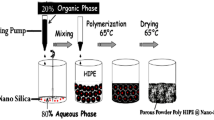Abstract
The Fe3O4/polythiophene nanoparticles, possessing core–shell structure, were prepared by two-step method. In the first step, the Fe3O4 particles were synthesized via co-precipitation of FeCl3 and FeSO4, using the NH3·H2O and N2H4·H2O as precipitant system. In the second step, the thiophene adsorbed and polymerized on the surface of the Fe3O4 in the solvent of chloroform. Raman, FTIR, EDS, XRD, TEM, Zeta potential measurement and TG-SDTA were employed to characterize the composition and structure of the products. The results showed that the Fe3O4/polythiophene nanoparticles were successfully synthesized with good dispersion and stable core–shell structure, provided with average particle size of approximately 20 nm, in which the diameter of Fe3O4 core was approximately 14 nm and the thickness of polythiophene shell was approximately 3–4 nm. Then, the nanoparticles were added into alkyd varnish to prepare a composite coating. The neutral salt spray test, paraffin control test and mechanical test were carried out to identify the properties of the composite coating. It was found that the composite coating had good performances of anticorrosion and paraffin controlling when the mass fraction of the nanoparticles was 0.8–1 wt% in alkyd varnish. As a multifunctional material, the Fe3O4/polythiophene nanoparticles can be used in the internal coating of pipeline and have great potential application in crude oil pipeline transportation.

















Similar content being viewed by others
References
Bordalo SN, Oliveira RC (2007) Experimental study of oil/water flow with paraffin precipitation in subsea pipelines. SPE 110810
Brodinova J, Stejskalb J, Kalendová A (2007) Investigation of ferrites properties with polyaniline layer in anticorrosive coatings. J Phys Chem Solids 68:1091–1095
Cechalova V, Kalendová A (2007) Properties of ZnO in dependence on method of preparation and size distribution in coatings. J Phys Chem Solids 68:1096–1100
Chen DJ (2006) Applied chemistry of oil and gas fields. Petroleum Industry Press, Beijing
Dhoke SK, Khanna AS (2009a) Effect of nano-Fe2O3 particles on the corrosion behavior of alkyd based waterborne coatings. Corros Sci 51:6–20
Dhoke SK, Khanna AS (2009b) Electrochemical behavior of nano-iron oxide modified alkyd based waterborne coatings. Mater Chem Phys 117:550–556
Dhoke SK, Khanna AS, Sinhab TJM (2009) Effect of nano-ZnO particles on the corrosion behavior of alkyd based waterborne coatings. Prog Org Coat 64:371–382
Dollish FR, Fateley WG, Bentley FF (1974) Characteristic Raman frequencies of organic compounds. Wiley, New York
Hong RY, Li JH, Cao X, Zhang SZ, Di GQ, Li HZ, Wei DG (2009) On the Fe3O4/Mn1−x Zn x Fe2O4 core/shell magnetic nanoparticles. J Alloys Compd 480:947–953
Jiang XM, He WP (1992) A concise method to read infrared spectra, vol 1. Guangxi Normal University press, Guilin
Jin Y, Sun X, Xue Q (2008) X-ray diffraction analysis. National Defense Industry Press, Beijing
Kalendová A, Sapurina I, Stejskal J, Vesely D (2008a) Anticorrosion properties of polyaniline-coated pigments in organic coatings. Corros Sci 50:3549–3560
Kalendová A, Vesely D, Stejskal J, Trchova M (2008b) Anticorrosion properties of inorganic pigments surface-modified with a polyaniline phosphate layer. Prog Org Coat 63:209–221
Li XG, Huang MR, Duan W, Yang YL (2002) Novel multifunctional polymers from aromatic diamines by oxidative polymerizations. Chem Rev 102:2925–3030
Li XG, Huang MR, Zeng JF, Zhu MF (2004) The preparation of polyaniline waterborne latex nanoparticles and their films with anti-corrosivity and semi-conductivity. Colloids Surf A 248:111–120
Li XG, Li J, Meng QK, Huang MR (2009a) Interfacial synthesis and widely controllable conductivity of polythiophene microparticles. J Phys Chem B 113(29):9718–9727
Li XG, Li J, Huang MR (2009b) Facile optimal synthesis of inherently electroconductive polythiophene nanoparticles. Chem Eur J 15(26):6446–6455
Maze, Lelong EG, Dorsett GL, Guhde TE, Nishikawa DJ, Toshio (2006) United States Patent 7,078,076
Maze, Mocquery E, Millet C, Espinosa B, Iandoli AF (2007) United States Patent 7,250,076
Mošner P, Kalendová A, Koudelka L (2000) Anticorrosion properties of SrO–ZnO B2O3–P2O5 pigments. Dyes Pigments 45:29–34
Poulet, Marie J, Chesneau, Alain, Delhalle, Carmen (2006) United States Patent 20060261311
Prokes P, Kalendová A (2007) Anticorrosion efficiency of coatings containing metallic pigments. J Phys Chem Solids 68:1083–1086
Štengl V, Šubrt J, Bakardjieva S, Kalendová A, Kalenda P (2003) The preparation and characteristics of pigments based on mica coated with metal oxides. Dyes Pigments 58:239–244
Tuken T, Yazici B, Erbil M (2004) The use of polythiophene for mild steel protection. Prog Orog Coat 51:205–212
Tung NP, Vuong NV, Long BQK, Vinh NQ, Hung PV, Hue VT, Hoe LD (2001) Studying the mechanism of magnetic field influence on paraffin crude oil viscosity and wax deposition reductions. SPE 68749
Uygun A, Turkoglu O, Sen S, Ersoy E, Yavuz AG, Batir GG (2009) The electrical conductivity properties of polythiophene/TiO2 nanocomposites prepared in the presence of surfactants. Curr Appl Phys 9:866–871
Vesely D, Kalendová A (2008) Anticorrosion efficiency of ZnxMgyAl2O4 core–shell spinels in organic coatings. Prog Org Coat 62:5–20
Vu QT, Pavlik M, Hebestreit N, Rammelt U, Plieth W, Pfleger J (2005) Nanocomposites based on titanium dioxide and polythiophene: structure and properties. React Funct Polym 65:69–77
Wang B, Dong L (1995) Paraffin characteristics of waxy crude oils in china and the methods of paraffin removal and inhibition. SPE 29954
Wang HM, Tang GQ, Jin SS, Bian CX, Han FF, Liang D, Xu XC (2007) Effect of the preparation condition on the structure and conductive properties of polythiophene. Acta Chimica Sinica 65(21):2454–2458
Xie HW, Liu SY, Wang LX (1995) Thermal decomposition processes of some electrically conducting polymers investigated by direct pyrolysis mass spectrometry. Acta Chimica Sinica 53:173–177
Zhang YT, Yu T (2008) Chemistry of colloid and interface. China Textile Industry Press, Beijing
Author information
Authors and Affiliations
Corresponding author
Rights and permissions
About this article
Cite this article
Liu, H., Zhuang, J. & Yang, J. Preparation and application of core–shell Fe3O4/polythiophene nanoparticles. J Nanopart Res 13, 6919–6930 (2011). https://doi.org/10.1007/s11051-011-0599-1
Received:
Accepted:
Published:
Issue Date:
DOI: https://doi.org/10.1007/s11051-011-0599-1




